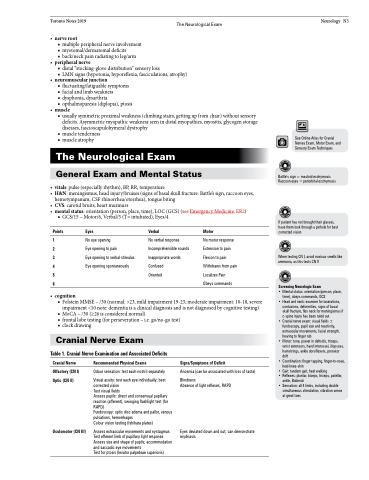Page 745 - TNFlipTest
P. 745
Toronto Notes 2019
The Neurological Exam
Neurology N3
• nerveroot
■ multiple peripheral nerve involvement ■ myotomal/dermatomal deficits
■ back/neck pain radiating to leg/arm
• peripheralnerve
■ distal “stocking-glove distribution” sensory loss
■ LMN signs (hypotonia, hyporeflexia, fasciculations, atrophy)
• neuromuscularjunction
■ fluctuating/fatiguable symptoms ■ facial and limb weakness
■ dysphonia, dysarthria
■ opthalmoparesis (diplopia), ptosis
• muscle
■ usually symmetric proximal weakness (climbing stairs, getting up from chair) without sensory deficits. Asymmetric myopathic weakness seen in distal myopathies, myositis, glycogen storage diseases, fascioscapulohymeral dystrophy
■ muscle tenderness
■ muscle atrophy
The Neurological Exam
General Exam and Mental Status
• vitals:pulse(especiallyrhythm),BP,RR,temperature
• H&N:meningismus,headinjury/bruises(signsofbasalskullfracture:Battle’ssign,raccooneyes,
hemotympanum, CSF rhinorrhea/otorrhea), tongue biting
• CVS:carotidbruits,heartmurmurs
• mentalstatus:orientation(person,place,time),LOC(GCS)(seeEmergencyMedicine,ER2)
See Online Atlas for Cranial Nerves Exam, Motor Exam, and Sensory Exam Techniques
Battle’s sign = mastoid ecchymosis Raccoon eyes = periorbital ecchymosis
If patient has not brought their glasses, have them look through a pinhole for best corrected vision
When testing CN I, avoid noxious smells like ammonia, as this tests CN V
Screening Neurologic Exam
• Mental status: orientation (person, place, time), obeys commands, GCS
• Head and neck: examine for lacerations, contusions, deformities, signs of basal skull fracture, flex neck for meningismus if c-spine injury has been ruled out
• Cranial nerve exam: visual fields ± fundoscopy, pupil size and reactivity, extraocular movements, facial strength, hearing to finger rub
• Motor: tone, power in deltoids, triceps, wrist extensors, hand interossei, iliopsoas, hamstrings, ankle dorsiflexors, pronator drift
• Coordination: finger tapping, finger-to-nose, heel-knee-shin
• Gait: tandem gait, heel walking
• Reflexes: plantar, biceps, triceps, patellar,
ankle, Babinski
• Sensation: all 4 limbs, including double
simultaneous stimulation, vibration sense at great toes
■ GCS/15 – Motor/6, Verbal/5 (T= intubated), Eyes/4
Points
1 2 3 4 5 6
Eyes
No eye opening
Eye opening to pain
Eye opening to verbal stimulus Eye opening spontaneously
Verbal
No verbal response Incomprehensible sounds Inappropriate words Confused
Oriented
Motor
No motor response Extension to pain Flexion to pain Withdraws from pain Localizes Pain
Obeys commands
• cognition
■ Folstein MMSE – /30 (normal: >23, mild impairment 19-23, moderate impairment: 10-18, severe
impairment <10 note: dementia is a clinical diagnosis and is not diagnosed by cognitive testing)
■ MoCA – /30 (≥26 is considered normal)
■ frontal lobe testing (for perseveration – i.e. go/no-go test)
■ clock drawing
Cranial Nerve Exam
Table 1. Cranial Nerve Examination and Associated Deficits
Cranial Nerve
Olfactory (CN I) Optic (CN II)
Oculomotor (CN III)
Recommended Physical Exams
Odour sensation: test each nostril separately
Visual acuity: test each eye individually; best corrected vision
Test visual fields
Assess pupils: direct and consensual pupillary reaction (afferent), swinging flashlight test (for RAPD)
Fundoscopy: optic disc edema and pallor, venous pulsations, hemorrhages
Colour vision testing (Ishihara plates)
Assess extraocular movements and nystagmus Test efferent limb of pupillary light response Assess size and shape of pupils; accommodation and saccadic eye movements
Test for ptosis (levator palpebrae superioris)
Signs/Symptoms of Deficit
Anosmia (can be associated with loss of taste)
Blindness
Absence of light reflexes, RAPD
Eyes deviated down and out; can demonstrate mydriasis


